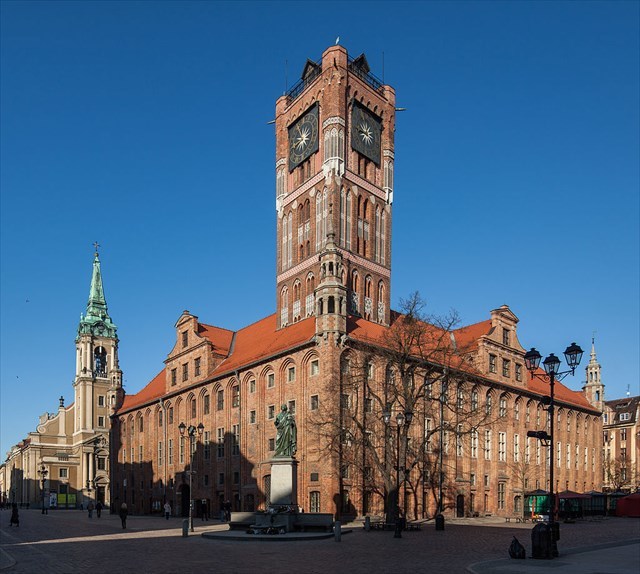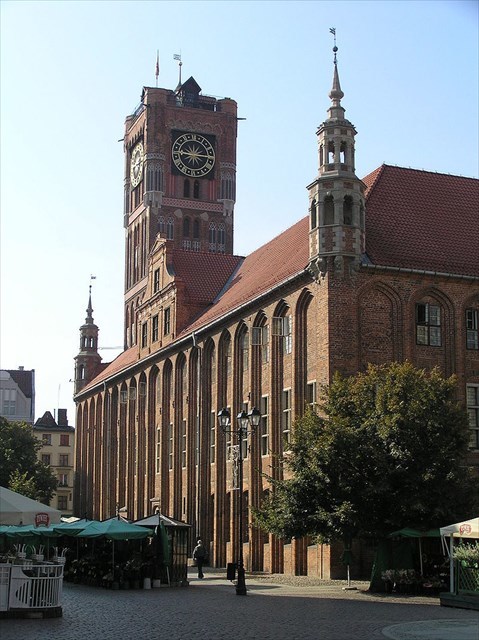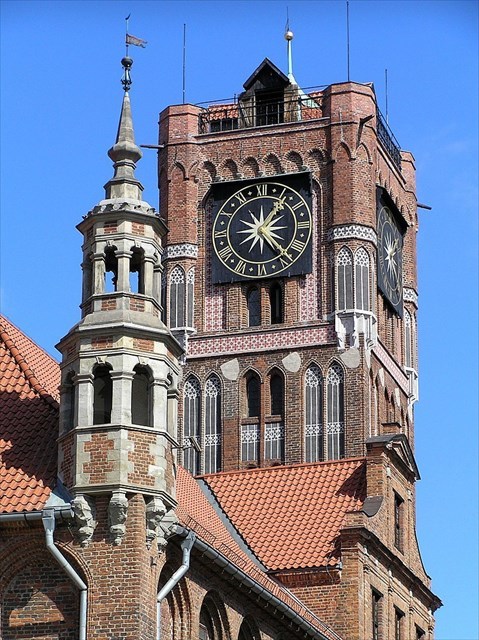
Ratusz Staromiejski w Toruniu
 |
POLISH DESCRIPTION |
Zlokalizowany w samym sercu toruńskiej zabytkowej starówki Ratusz Staromiejski, z historycznego punktu widzenia najważniejszy budynek w mieście, jest jedną z największych i najpiękniejszych tego typu budowli w Europie. Zbudowany na planie kwadratu z wewnętrznym dziedzińcem stanowi symbol gotyckiego Zespołu Staromiejskiego, wpisanego w 1997 roku na Listę Światowego Dziedzictwa UNESCO.
Przez wieki w Ratuszu Staromiejskim koncentrował się handel oraz życie publiczne i polityczne miasta. Ratusz był głównym ośrodkiem sądowym i siedzibą rady miejskiej. Podejmowano tu władców: wielkich mistrzów zakonu krzyżackiego, a przede wszystkim królów Polski, którym wówczas gmach ten służył za czasową rezydencję. Z tego też powodu jedna z sal pierwszego piętra nosi nazwę Sali Królewskiej. To właśnie w niej zmarł król Jan Olbracht (w 1501 roku). W Ratuszu Staromiejskim miały miejsce także inne ważne wydarzenia historyczne: w 1454 roku wysłannicy króla polskiego Kazimierza Jagiellończyka odebrali przysięgę wierności od przedstawicieli stanów ziem pruskich, a w 1645 roku, z inicjatywy króla Władysława IV, odbyła się „braterska rozmowa” pomiędzy katolikami i protestantami (Colloquium Charitativum). Obradowały tu sejmiki pruskie, a nawet sejmy polskie w latach 1520, 1576 i 1626 oraz sądy ziemskie chełmińskie.
Obecnie Ratusz Staromiejski jest główną siedzibą Muzeum Okręgowego w Toruniu i miejscem wielu uroczystości oraz wydarzeń o charakterze kulturalnym i nie tylko. W jego wnętrzach podziwiać można m.in. Galerię Sztuki Gotyckiej z kolekcją unikatowych XIV-wiecznych witraży, ekspozycję prezentującą historię i rzemiosło artystyczne lat 1233–1793, wystawę Mennice i monety toruńskie 1233/1238–1765, Salę Mieszczańską z galerią portretów wybitnych mieszczan Torunia (XVI–XVIII wiek), w której znajduje się również portret Mikołaja Kopernika – bodaj najsłynniejszy wizerunek astronoma na świecie, Salę Królewską z najstarszym w kraju Pocztem królów polskich, kolekcję biżuterii Skarb ze Skrwilna, Skarb z Nieszawy czy imponującą Galerię malarstwa polskiego od poł. XVIII w. do 2010 roku, z dziełami Jana Matejki, Wojciecha Gersona, Stanisława Ignacego Witkiewicza, Jacka Malczewskiego, Juliana Fałata, Andrzeja Wróblewskiego czy Zdzisława Beksińskiego.
Dodatkową atrakcją jest dostępny siedem dni w tygodniu taras widokowy ulokowany na szczycie 40-metrowej Wieży Ratuszowej, z którego podziwiać można gród Kopernika w całej jego okazałości.
Źródło tekstu: Muzeum Okręgowe w Toruniu
Zdjęcia: Wikipedia
JAK ZALOGOWAĆ KESZA?
Zrób sobie zdjęcie przed główną bramą pod herbem. Może być tylko przedmiot osobisty (telefon, GPS, WoodGeocoin), a swoje zdjęcie zamieść w logu.

Tawn Hall in Toruń
 |
ENGLISH DESCRIPTION |
Located in the heart of the historic Old Town of Toruń, the Old Town Hall is not only one of the most important historic buildings in the city, but also one of the largest and most beautiful constructions of this type in Europe. Built on a square plan with an inner courtyard, it is a symbol of the Gothic Old Town Complex which became a UNESCO World Heritage Site in 1997.
For centuries, the Old Town Hall was the centre of trade and the city’s public and political life. The Town Hall was also the main centre of judicial power and the seat of the city council. It was the place where rulers were officially hosted – the great masters of the Teutonic Order, and foremost the kings of Poland for whom the hall served as a temporary residence. Because of this, one of the rooms on the first floor is called the Royal Hall. It was also the place where King Jan Olbracht died in 1501. The walls of the Old Town Hall bore witness to great many historical events: in 1454, the envoys of the Polish king Casmir IV Jagiellon received an oath of loyalty from the representatives of the estate of the lands of Prussia, and in 1645, Catholics and Protestants met together at the invitation of King Władysław IV Vasa for a so-called “brotherly conversation” (colloquium charitativum). The proceedings of Prussian sejmiks (dietines), and even Polish sejms (diets) were held here in 1520, 1576 and 1626, as well as those of the land courts for the Chełmno region.
Currently, the Old Town Hall is the main seat of the District Museum in Toruń and a venue in which many celebrations, cultural events, and other gatherings are organised. The Hall houses such attractions as the Gallery of Gothic Art, with its collection of unique 14th-century stained glasses, an exhibition presenting the history and artistic handicrafts from the period of 1233-1793, an exhibition on the mints and coins of Toruń from the period of 1233/1238-1765, the Grand Hall with a gallery of portraits of prominent Toruń patricians (from the period of 16th-18th century), including a portrait of Nicolaus Copernicus – probably the most famous image of the astronomer in the world, as well as the Royal Hall with the oldest collection of Polish kings’ portraits, a jewellery collectionsreferred to as the Skrwilno Treasureand the Nieszawa Treasure, and an impressive gallery of Polish paintings from mid-18th century to 2010, which includes works of Jan Matejko, Wojciech Gerson, StanisławIgnacyWitkiewicz, Jacek Malczewski, Julian Fałat, Andrzej Wróblewski and ZdzisławBeksiński.
An observation deck located at the top of 40-metre-high Town Hall Tower is another popular attraction. Open seven days a week, it offers a panoramic view of the entire city of Toruń in all its glory.
Text surce: Muzeum Okręgowe w Toruniu
Photo: Wikipedia
HOW TO LOG THE VIRTUAL?
Take a picture of yourself in front of the main gate under the coat of arms. It can only be a personal item (phone, GPS, WoodGeocoin), and include your photo in the log.

Rathaus in Thorn
 |
GERMAN DESCRIPTION |
Das im Herzen der historischen Altstadt von Toruń gelegene Altstädtisches Rathaus ist, aus historischer Sicht, das wichtigste Gebäude der Stadtsowie das größte und schönste Bauwerk dieser Art in Europa.Es wurde auf einem quadratischen Grundriss mit Innenhof erbaut und ist ein gotisches Symbol eines Altstädtischen Komplexes, der im Jahre1997 zum Welterbe der UNESCO ernannt wurde.
Im Altstädtischen Rathauskonzertierte sich durch die Jahrhunderte der Handel sowie das öffentliche und politische Lebender Stadt. Das Rathaus diente als Hauptgerichtsgebäude und Sitz des Stadtrates. Hier empfing man die Herrscher: die Hochmeister des Kreuzritterordens und vor allem die polnischen Könige, die das Gebäude als vorübergehende Residenz nutzten. Aus diesem Grund trägt einer der Säle im ersten Stock den Namen „Königlicher Saal“. In diesem Saal ist KönigJohann I. Albrecht (im Jahre 1501) gestorben. Im Rathaus fanden auch andere historische Ereignisse statt: im Jahre 1454 empfingen hier die Gesandten des polnischen Königs Kasimir IV. Andreas den Treueeid von den Vertretern der Stände der 47preußischen Gebiete und im Jahr 1645 fand an diesem Ort, auf Initiative des Königs Władysław IV. Wasa ein„brüderlichesGespräch“zwischen Katholiken und Protestanten statt (Colloquium Charitativum). Hier fanden die Beratungen des preußischen Landtags und sogar polnische Ständeversammlungen in den Jahren 1520, 1576 und 1626 und das Kulmer Landtags statt.
Gegenwärtig ist das Altstädtische Rathaus der Hauptsitz des Bezirks-Museums in Toruń und ein Ort, an dem viele Feierlichkeiten sowie kulturelle Ereignisse und vieles mehr organisiert werden.Hier kann man u. a. die Galerie der gotischen Kunst mit der Sammlung einzigartiger bunter Kirchenfenstern aus dem XIV. Jh., die Ausstellung zur Geschichte und zum künstlerischen Handwerk in den Jahren 1233–1793, die Ausstellungüber Münzstätten und Münzen aus Toruń in den Jahren 1233/1238–1765, den Bürgerlichen Saal mit der Galerie von Porträts berühmter Toruńs Bewohner (XVI.–XVIII.Jh.), in dem sich auch das Porträt von Nikolaus Kopernikus befindet –die wohl bekannteste Darstellung des Astronoms in der Welt–, den Königlichen Saal mit der in Polen ältesten Sammlung von Porträts polnischer Könige, die Schmucksammlung „Schatz aus Skrwilno“, „Schatz aus Nieszawa“ oder die beeindruckende Galerie der polnischen Malerei vom Ende des XVIII.Jh.bis zum Jahr 2010, mit Werken von Jan Matejko, Wojciech Gerson, Stanisław IgnacyWitkiewicz, JacekMalczewski, Julian Fałat, Andrzej Wróblewski oder ZdzisławBeksiński bewundern.
Eine zusätzliche Attraktion ist die Aussichtsterrasse auf dem 40 Meter hohen Rathausturm, die die ganze Woche zugänglich ist und eine wunderschöne Aussicht auf die Kopernikus-Stadt bietet.
Textqelle: Muzeum Okręgowe w Toruniu
Foto: Wikipedia
NUN EURE AUFGABE:
Machen Sie ein Foto von sich vor dem Haupttor unter dem Wappen. Es kann nur ein persönlicher Gegenstand sein (Telefon, GPS, WoodGeocoin) und Ihr Foto im Protokoll enthalten.
Virtual Rewards 3.0
This Virtual Cache is part of a limited release of Virtuals created between March 1, 2022 and March 1, 2023. Only 4,000 cache owners were given the opportunity to hide a Virtual Cache. Learn more about Virtual Rewards 3.0 on the Geocaching Blog.